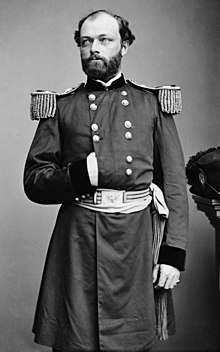| Morgan |
| Tebbs Bend Battlefield |
Bragg had given Morgan permission to go wherever he wished as long has he did not cross the Ohio River, but Morgan however had no intention to obey these orders. He thought that the Federals would not be really concerned about the raid unless it struck their homeland. On July 8th he captured two steamboats and used them to cross the river into Indiana. The Union district commander, Ambrose Burnsides, send whatever troops he could to meet the rebel invaders, but Morgan brushed away his pursuers. Whenever he encountered telegraph lines he would have his telegrapher, George “Lightning” Ellsworth tap into the line and send disinformation out to the Union forces, highly exaggerating the number of the Confederate cavalry.
Riding east, Morgan's men entered Ohio on July 13th. Although he had not been caught, his raid began to fall apart. He had suffered 500 casualties and men and horses were falling by the wayside broken down in exhaustion. They headed for the Ohio river, where they planned to cross into West Virginia. He encountered militia at Buffington Island, and decided to attack the next morning. But by that time the Union forces had begun to close on the tired raiders. The Confederates now also had to face two brigades of Union troops and a fleet of gunboats. Morgan, soon realizing that the way was blocked, tried to leave a rearguard to hold of the numerous Federals and find another ford. But Union columns split up his force, and 750 Confederates were captured, Morgan escaping with only about 700.
His escape across the river cut off, so he headed north. The Ohio River was higher than normal and with the Federal cavalry close behind he could not find a place to cross the river. At one point his men began to cross, but midway through the Union gunboats and cavalry arrived. Morgan decided to remain with the half still on the Ohio side of the river while the rest made it to safety. He was finally caught near the West Virginia Pan Handle 150 years ago today with less than 400 men left. Realizing they were surrounded, the rebels tried to cut their way out. In 1 ½ hours the Confederate force was shattered, with only Morgan and a few men making it through the Federal lines. But even they wouldn't remain free for long. Knowing it was hopeless to try to head south, and seeing Union forces hot on his trail Morgan surrendered to one of his prisoners, an Ohio militia captain, who then immediately paroled his former captor. But when the Union cavalry arrived, they forced him to surrender again and refused to give him a parole.
His men had ridden 1000 miles, and achieved the furthest north reached by a Confederate force during the war. Because of incorrect rumors of what had been done to similar Northern prisoners, Morgan and his officers were sent to a prison instead of a POW camp. They were not given parole, were forced to wear convict clothes and had their hair and beards shaved. A few months later, Morgan would escape with six of his men and return to the Confederacy humiliated, having lost some of the South's best cavalry.





